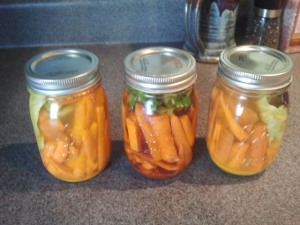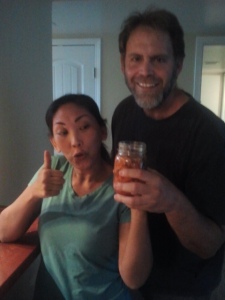
When I visited my friends in Thailand, Aaron Blue took me to the Charis Consignment Shop and Coffee Bar to give me a tour. While we were there, he held up a glass gallon jar in one hand and declared, “You’ve got to try these carrots. They are chaulked full of the healthiest probiotics and nutrients. You’ll love them.” They were, of course, fermented carrots. I’m really not a fan of pickles (which are no longer fermented as they used to be), but being in the adventurous spirit that Thailand both demands and imbues, I gave them a try. Acidic and salty met my tongue. I smiled and swallowed. “They’re pretty good,” is what I said, but I was thinking, “What the hell was that?”
A few more days of being around Aaron, being overwhelmed by his charismatic words and strong opinions, I started to succumb to some of his “healthier” ideas of nutrition. Of course, most of what I’m learning these days about nutrition is hundreds of years old and has only been lost to us since the mid-1900s with the invention of the word “convenience.” But before the dawn of the 20th century, fermented foods like saurekraut and fermented carrots were commonplace. The voyager, James Cook, actually took sauerkraut with him on his voyages to prevent scurvy. Today, it’s difficult to go to a North Park cafe without being offered Kambucha. Fermentation is back with a vengance; I can only hope that it’s here to stay.
So why fermented foods you may ask? I’m still learning this one. My personal bent on nutrition is, “If we ate it before modern conveniences, it’s probably better for you than processed and GMO foods.” There are hundreds of articles online to answer this question, so I’ll quickly summarize the benefits:
- Probiotics – the bacteria that help to ferment the food also help you digest better
- Nutrients – the acidic environment of fermentation frees up and preserves vitamins and minerals
- Healing benefits:
- Some fermented foods are said to help prevent and treat cancer
- They can help to treat ulcers
- They can help with upset stomach
- Many more, I recommend doing your own search!

I’d been having a desire to make some kimchi for the last couple months, but being so emotionally drained from the process of moving and never having the right resources on hand when I actually felt like making it, I never got around to it. But two weeks ago, I’d just pulled up the carrots and I was inspired. I remembered the carrots that Aaron gave me and thought, I think I can do this. I looked up the recipe and I was blown away by how simple it was. These are the ingredients:
- Water
- Salt
- Carrots
- The outer leaf of a cabbage

Does it get any simpler? You literally take all the ingredients and throw them in a jar. The naturally occurring “yeasts” which are actually anaerobic bacteria, like lactobacillus and pediococcus (I’d never heard of this one), inoculate the mixture of salt water and carrots. They produce lactic acid, making their environment too acidic for anything except themselves to live. This causes the carrots to keep longer and adds some bite to the flavor. I added spices to mine to vary the flavor. My favorite was ginger/garlic; the mixture of sweet, sour, bitter, spicy and salty mingle wonderfully. In another I added cilantro, crushed red pepper and cumin; I highly recommend this as an introduction if you like salsa.

I realize that fermented foods are now the new crossfit and paleo from 5 years ago. I think we all can see that Kambucha will not be as popular years from now. But what I admire is what is at the heart of these health-conscious fads. We, the human race, are hungry for something real and beautiful, something that makes sense for us and brings value to our lives. We are all searching for tools that will help us find our Good Life. I hope this post proves to be one of those tools for you.
Question: Do you have to sterilize the glass jars like I remember my grandma doing before she would can her pickles and jellies?
LikeLike
I think it probably isn’t a bad idea to do this, but I didn’t. I figure that you’re also going to introduce the “bad” bacteria with all the non-sterile veggies. Cleaning the jars well and drying them prior to beginning the process should be sufficient. One thing I didn’t mention is that the carrots need to stay below the surface of the water, so you need to have wedge them in the jar against the walls.
I’ll be making a Recipe Page soon on this blog. This will be the first one to go up and it will have a little more technical information. I try not to be too wordy in the posts to keep the reader’s attention and save you time.
LikeLike
Good fermented food is a super help when getting your gut accustomed to a new environment. It keeps your system strong so that the inevitable stressors have a harder time knocking you out.
LikeLike
That’s my strategy for Thailand bro. Thanks for getting us into this in the first place!
LikeLike